
The Canary Islands, also known informally as the Canaries, are a Spanish autonomous community and archipelago in Macaronesia in the Atlantic Ocean. At their closest point to the African mainland, they are 100 kilometres west of Morocco and the Western Sahara. They are the southernmost of the autonomous communities of Spain. The islands have a population of 2.2 million people and are the most populous special territory of the European Union.

La Palma, also known as La isla bonita and historically San Miguel de La Palma, is the most northwesterly island of the Canary Islands, Spain. La Palma has an area of 708 square kilometres (273 sq mi) making it the fifth largest of the eight main Canary Islands. The total population at the end of 2020 was 85,840, of which 15,716 lived in the capital, Santa Cruz de La Palma and about 20,467 in Los Llanos de Aridane. Its highest mountain is the Roque de los Muchachos, at 2,426 metres (7,959 ft), being second among the peaks of the Canaries after the Teide massif on Tenerife.

Lanzarote is a Spanish island, the easternmost of the Canary Islands in the Atlantic Ocean. It is located approximately 125 kilometres off the north coast of Africa and 1,000 kilometres from the Iberian Peninsula. Covering 845.94 square kilometres, Lanzarote is the fourth-largest of the islands in the archipelago. With 152,289 inhabitants at the start of 2019, it is the third most populous Canary Island, after Tenerife and Gran Canaria. Located in the centre-west of the island is Timanfaya National Park, one of its main attractions. The island was declared a biosphere reserve by UNESCO in 1993. The island's capital is Arrecife, which lies on the eastern coastline. It is the smaller main island of the Province of Las Palmas.

Pinus canariensis, the Canary Island pine, is a species of gymnosperm in the conifer family Pinaceae. It is a large, evergreen tree, native and endemic to the outer Canary Islands of the Atlantic Ocean.

Echium is a genus of flowering plants in the family Boraginaceae that contains about 70 species and several subspecies.

Echium wildpretii is a species of flowering plant in the family Boraginaceae. It is an herbaceous biennial plant that grows up to 3 m (10 ft) in height. The species is endemic to the Canary Islands, and is found mainly in the national park surrounding Mount Teide in Tenerife. The subspecies E. wildpretii subsp. trichosiphon occurs at high altitudes on the island of La Palma. The common names are tower of jewels, red bugloss, Tenerife bugloss or Mount Teide bugloss.

Malva phoenicea, often still known under the synonyms Lavatera phoenicea and Navaea phoenicea, is a large shrub of the family Malvaceae and tribe Malveae, endemic to the island of Tenerife in the Canary Islands.
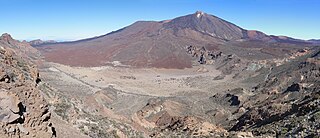
Teide National Park is a national park located in Tenerife, Canary Islands, Spain.

Echium pininana, commonly known as the tree echium, pine echium, giant viper's-bugloss, or tower of jewels, is a species of flowering plant in the borage family Boraginaceae. It is endemic to the Canary Islands, where it is restricted to the island of La Palma. Echium pininana is an endangered species, and is listed in Appendix I to, and is therefore protected under, the Convention on the Conservation of European Wildlife and Natural Habitats. The specific epithet pininana is Latin for "small pine", though E. pininana is neither closely related to the pine, nor does it resemble that plant.

Echium wildpretii subsp. trichosiphon is a species of Echium that is found high up in the area of La Caldera de Taburiente on the Canary Island of La Palma. Like its sister plant on Tenerife, this plant forms a large rosette of silvery leaves which eventually give rise to tall spikes of bright pink flowers. The plant is biennial and dies after flowering. This plant can be grown in gardens, but requires good drainage and fairly mild conditions. The plant hates water falling in the centre of the rosette and will often rot in such conditions.
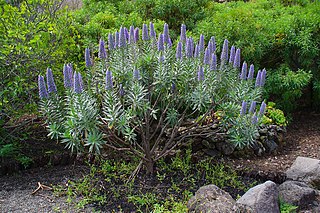
Echium webbii is a species of flowering plants of the family Boraginaceae. It is endemic to the Canary Islands, where it is restricted to the island of La Palma. The species was first described by Auguste-Henri de Coincy. The specific name webbii refers to botanist Philip Barker Webb.
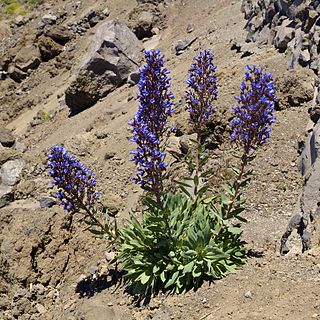
Echium gentianoides is a synonym of Echium thyrsiflorumMasson ex Link., a flowering plant in the borage family Boraginaceae with brilliant blue tubular flowers. It is endemic to the island of La Palma, the Canary Islands. It occurs in one location of La Caldera de Taburiente where it grows in sunny, rocky sites at altitudes higher than 1.800 m. The main threat described for this species is predation by goats and insects.
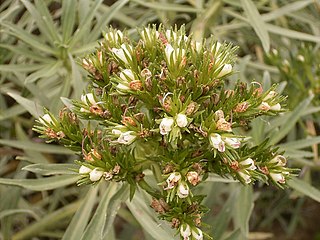
Echium brevirame is a species of flowering plants of the family Boraginaceae. It is endemic to the Canary Islands, where it is restricted to the island of La Palma.

Echium hypertropicum is a species of flowering plants of the family Boraginaceae. The species is endemic to Cape Verde. It is listed as an endangered plant by the IUCN.
The Gran Canaria giant tortoise is an extinct species of cryptodire turtle in the family Testudinidae endemic to the island of Gran Canaria, in the Canary Islands.
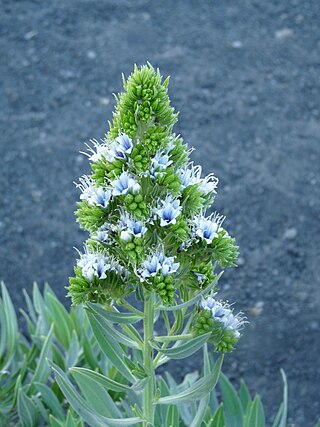
Echium vulcanorum is a species of flowering plants of the family Boraginaceae. The species is endemic to Cape Verde. It is listed as an endangered plant by the IUCN. The species was first described in 1935 by Auguste Chevalier. Its local name is língua-de-vaca, a name that may also refer to the related species Echium hypertropicum and Echium stenosiphon. The oil of its seeds contains γ-linolenic acid, and is used for medicinal and dietary purposes.
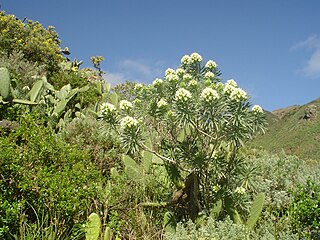
Echium leucophaeum is a species of flowering plants of the family Boraginaceae. It is endemic to the Canary Islands, where it is restricted to the island of Tenerife. Its name in Spanish is taginaste de Anaga. The specific name leucophaeum is from Greek and means "greyish white".
Famara is the main mountainous massif in the north of the island of Lanzarote in the Canary Islands. It is the eastern slope of a volcano erupting in the Miocene. The cliffs of Famara are the remains of a caldera of about ten kilometres in diameter centred on the south of La Graciosa.
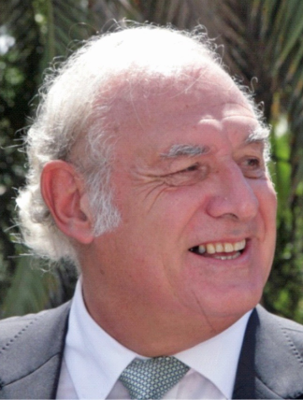
David Bramwell MBE was an English botanist and taxonomist, director of the Jardín Botánico Canario Viera y Clavijo, Gran Canaria (1974–2012), and active in the conservation of insular floras.

















